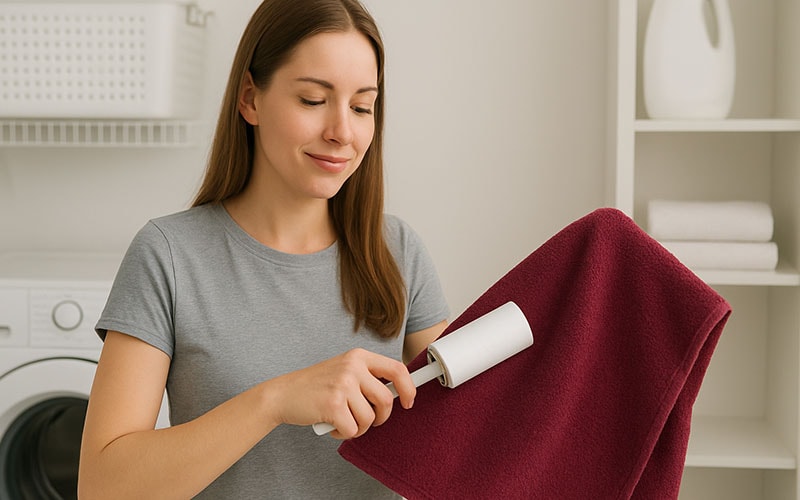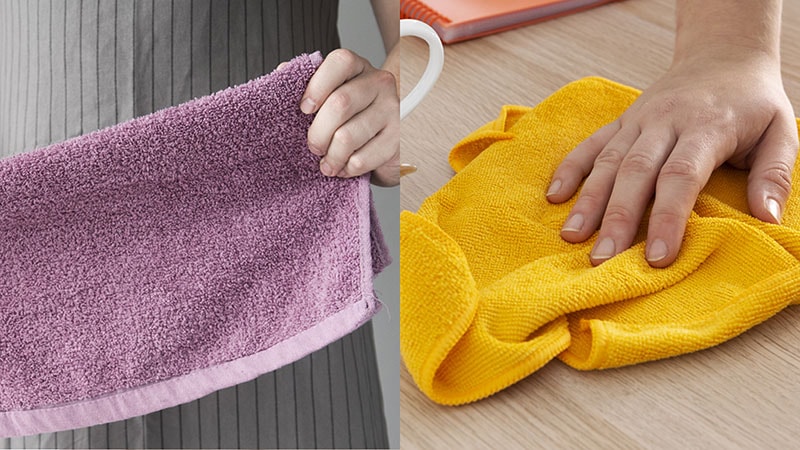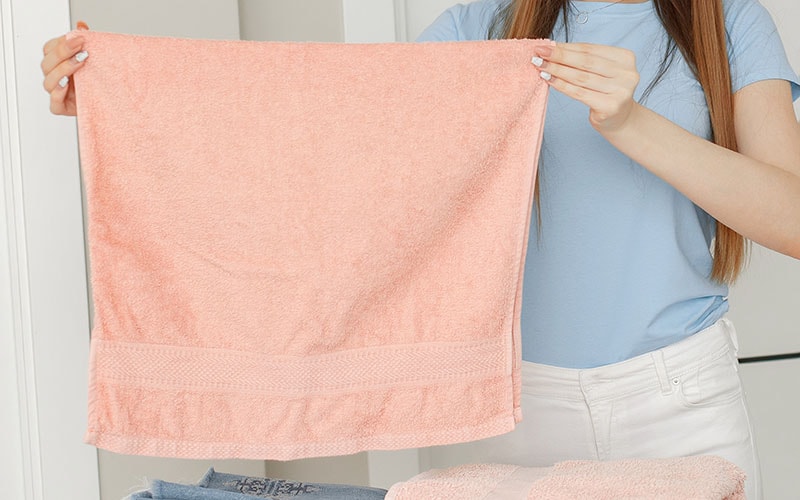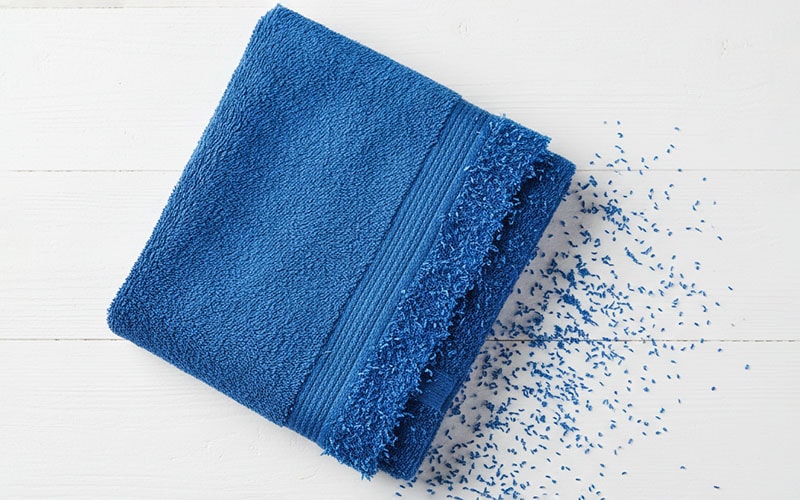Lint shedding is a common side effect of owning a towel. Over time, the towels will wear out and shed loose fibers. However, you may have seen new towels do the same. They came right from the store, have never been used, yet you can see all this extra lint around the house.
In this article, we dive deep into towel shedding, explain tips and tricks for lint removal, and cover towel washing and maintenance practices.
What Causes New Towels to Shed?

During manufacturing, some fibers get dislodged from towels. Longer twist loop, fibers detach more easily. Now, the soft towels, when rubbed against another surface, accumulate static charge on the surface. Static charges attract dust, lint, and other fabrics.
Hence, you find loose lint fibers even on your new towels. Due to their very design, all towels shed eventually. Whether you’re using fine Egyptian cotton or antimicrobial microfibers, even the best quality towels cannot avoid lint. However, some fabric materials and weave types can help reduce lint risk.
How to Wash New Towels and Remove Lint?

After the first few washes, you will remove most of the lint fibers from your fresh towels. But there is an easier way.
Here are four steps to help you properly wash your brand-new towels.
Step 1 – Separate Your Laundry
Wash your towels separately from other clothes. When different fabrics interact with one another, it results in increased lint production.
You also don’t want to mixcotton and microfiber towels. Because the loose fibers from your cotton towels will end up sticking to your microfiber ones.
Step 2 – Soak in Cold Water
Soak your new towels in cold water. The loose fibers will gently lift away from the surface and float in water. Alternatively, you can first wash your towels on a rinse cycle with cold water and no detergent. This cold treatment is essential to safe lint removal.
Step 3 – Gentle Detergent
Use the same gentle detergents that you use for washing your delicates. You can identify gentle washing supplies from their packaging.
- Look for mild or gentle labels on the packaging.
- Look for fragrance-free or low-fragrance branding.
- Avoid detergents with fabric softener and bleach.
Pair your mild detergent with a gentle wash cycle. Excess agitation contributes to lint production.
Step 4 – Avoid Fabric Softener
Fabric softeners soften your clothes by coating them in a positively charged film that reduces friction, resulting in less pilling and fuzzing. This method reduces lint generation but also affects water absorbency.
The fabric softener fills the air gaps in the towel fibers and creates a barrier for water absorption.
Step 5 – Low-Heat Dryer Cycle
Use the lowest heat setting on your tumble dryer. It should be labeled as low-heat, no-heat, or air fluff cycle on your dryer settings.
Alternatively, you can hang dry your towels in a shaded area away from direct sunlight. It’s a time-consuming method but a worry-free option, especially for delicate microfiber towels.
5 Ways to Remove Lint from Old Towels

Ok. But what if you have old towels that are shedding lint? Here are five ways to keep your old towels feeling fresh and soft.
- Hand Wash: Wash cycles can be rough, and hand washing is one of the most effective methods for removing lint.
- Lint Roller: Wipe your towels down with a soft lint roller. Give both sides a good wipe before washing.
- DIY Tape Method: Alternatively, you can use masking tape as a DIY lint roller. Lay the sticky side of the tape on the towel; don’t press it. Then gently lift it with the loose fibers.
- Soft Brush: Lightly brush your towels in one direction to get as many loose fibers as possible.
- White Vinegar: Soak your towels in a mixture of cold water and white vinegar before washing. Use one cup of vinegar for every gallon of water.
- Baking Soda: Mix half a cup of baking soda in a bucket of water and rinse your towels. Then wash to remove the excess baking soda.
Both white vinegar and baking soda help break down hard water deposits. We, and most manufacturers, don’t recommend adding vinegar or the baking soda solution directly to your washing machine.
Cotton vs Microfiber Towels

Manufacturers use long fibers to achieve a fluffy texture and make cotton towels more absorbent. However, these large fibers are also easy to damage. Body towels see daily use, which can also increase their chances of shedding.
In comparison, microfiber towels use shorter fibers with a tight weave. It significantly reduces lint shedding. Therefore, many manufacturers brand their microfiber cloths and towels as lint-free.
However, microfibers generate static electricity more easily. So microfibers don’t shed lint, but can attract loose lint from other sources.
- Cotton Towels: Use longer fiber strands that can shed over time.
- Microfiber Towels: Don’t shed but attract and hold on to lose fibers.
Microfiber cloths use high-quality materials, but that doesn’t mean they make stronger towels. The same properties that make microfiber towels soft also make them prone to “pilling“. Pilling occurs when a microfiber cloth rubs against a rough surface.
Lint is loose fibers that detach from the fabric, but are attached via static electricity. Pilling refers to damaged fibers that get tangled up and form into balls (called pills) on the fabric surface.
You can pick lint by hand, but you need to tear away pills from fabrics.
6 Simple Tips for Preventing Lint Shedding

Here are six simple tips to keep your towels lint-free.
- Give your new towels a good shake. Remove as much dry lint as you can before you wash.
- Always clean your lint trap. If your washing machine’s lint trap is already full, excess lint will stick back to your towels.
- Avoid dryer sheets because they act like fabric softeners. Towels covered in fabric softener feel fluffy but lose their water absorbency.
- You can opt for wool dryer balls. But they are less efficient than other methods shared in this article.
- Despite the internet’s claims, freezing your towels before washing doesn’t help. Putting towels in the freezer requires way too much effort, and the results are disappointing.
- If repeated washing doesn’t solve your lint problem. Then it’s time to trade in your old towels for brand-new ones.
Conclusion
Lint is a natural part of a towel’s life. New towels also have some loose lint fibers, but they go away after the first few washes. For older towels, proper prevention is the way to go. Use the tips and tricks from this article to ensure your towels stay soft and lint-free.
Get Clean Lint-Free Microfiber & Cotton Towels from Manwell!
Manywell has been producing high-quality cleaning supplies for over 17 years. We take pride in our lint-free microfiber towels and ultra-soft cotton towels.
All Manywell products are 100% customizable with quality guaranteed. We also offer competitive pricing and fast global shipping. Contact us for a Free Quote!




